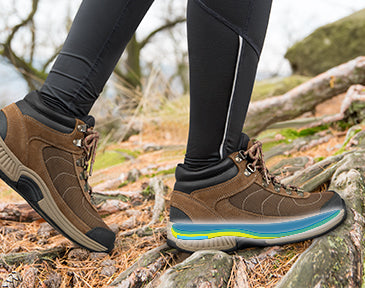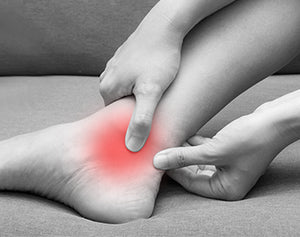The Orthofeet Blog
- All Posts
- All
- Arch Support
- Back Pain
- Bunions
- Diabetes
- Flat Feet
- Foot Pain
- Hammer Toes
- Heel Pain
- Heel Pain/ Heel Spurs
- Knee & Hip Pain
- Knee pain
- Morton Neuroma
- Orthopedic shoes
- Other
- Overpronation
- Plantar Fasciitis
- Swollen Feet
Plantar Fasciitis


Josh White DPM / August 12, 2021
Hiking with Plantar Fasciitis: What You Need to Know
Hiking with Plantar Fasciitis: What You Need to Know
Read Post-
Why Do My Feet Hurt Everyday? Understanding Daily Foot Pain
Medical information provided by Josh White DPM / November 01, 2024Discover why your feet hurt every day and learn about solutions to alleviate daily foot pain with Orthofeet's expert tips and recommended orthopedic products.Read More -
Pain on Outside of Foot: Orthopedic Shoes for Lateral Foot Pain
Medical information provided by Josh White DPM / November 01, 2024Explore the common causes and treatments for pain on the side of the foot. Learn how the right footwear can help manage and prevent outside foot pain.Read More -
9 Effective Ways to Alleviate Foot Pain from Standing All Day
Medical information provided by Josh White DPM / November 01, 2024Learn 9 effective ways to alleviate foot pain caused by standing all day, featuring Orthofeet’s orthopedic shoes designed for maximum comfort and support.Read More -
Stepping Confidently: What Are Slip-Resistant Shoes?
Medical information provided by Orthofeet Team / October 12, 2023Whether you're navigating a bustling kitchen, a sleek hospital corridor, a rain-slicked sidewalk, or any other surface that might be slippery or uneven, the need for stability and safety is universal. Luckily, we live in an era when the innovation of slip-resistant shoes already exists, helping to keep you on your feet when it matters most. So, what are slip-resistant shoes, how do they work and who should consider making them an essential part of their everyday wardrobe? Here’s everything you need to know about the footwear that allows you to walk confidently and securely. What are slip resistant shoes? Non-slip shoes, also known as slip resistant shoes, are specially designed footwear engineered with traction-enhancing soles and a slip-resistant sole to provide better grip on various surfaces. They are essential for: People who work in environments where slipping or falling poses a significant risk, such as restaurants, hospitals, industrial settings, or any place with wet, oily, or otherwise slippery floors. Explore the best shoes for healthcare workers with slip-resistant soles if you work in a related field. Older people, are typically more prone to slips and falls. Be sure to find the best walking shoes for seniors to avoid falls. Individuals working in environments with uneven surfaces, such as construction sites, or on slippery floors. Hikers, runners, and people who engage in other sports can benefit from improved grip and stability on various surfaces. Anyone seeking the peace of mind these shoes provide while walking or engaging in activities on their feet. What makes a shoe slip resistant? Slip resistant shoes are typically designed with a few key features: Outsoles with tread patterns shoes feature outsoles designed with specific tread patterns or rubber compounds that increase friction and prevent skidding. These tread patterns on slip-resistant shoes are strategically placed to enhance stability. The materials used in safety footwear construction are chosen for their slip-resistant properties to provide better traction than a regular shoe, offering even on slippery surfaces. These shoes are often designed to resist water, oil and other liquids, reducing the risk of slips in wet or greasy environments. In some cases, slip-resistant shoes may adhere to industry-specific safety standards to ensure they provide the necessary protection for particular work environments rather than everyday footwear. How do you know if you have slip resistant shoes? You can tell whether or not your shoes are slip resistant with a few simple steps: Look at the sole. Begin by looking at the sole of the shoe. A telltale sign of slip resistant footwear is a sole crafted from some type of high quality rubber. These materials provide traction, better grip, as well as cushioning and durability. Slip resistant soles are also rounded at the edges instead of being completely flat, so that liquids don’t get caught underneath. In addition, the soles of slip-resistant shoes are often thicker than those of standard shoes, especially if they are intended for work purposes. This added thickness contributes to increased support and foot protection. Look at the Tread. Pay close attention to the tread on the shoe's outsole, which should consist of grooves forming a specific pattern on the bottom of the shoe. These tread designs, while sometimes visually appealing, are primarily functional rather than decorative as they provide a better grip on slippery surfaces than everyday footwear. Look for patterns featuring small hexagons, circles, or squiggly lines, as these designs enhance the shoe's slip resistance by preventing liquids from getting trapped under the soles. As a general rule, a smaller and more pronounced tread pattern indicates better slip resistance. Try the shoes. The most important step is how you feel while wearing the shoes, so test them and see for yourself if they are slip resistant. Walk on a hard surface, such as tile or polished concrete, to check how effectively the shoe grips the floor. If you have the opportunity, try stepping on a slippery or wet surface to see how the shoe performs in such conditions.During your test, pay attention to other factors as well: the fit, support, cushioning and overall comfort of the shoes. Remember that while slip resistance is crucial, comfort is equally important, especially if you plan to wear the shoes for extended periods. Read the product description. Although it’s last on our list, checking the product description or tag is actually the easiest way to work out if your shoe is slip resistant or not. Look for phrases like ‘slip resistant’. These labels indicate that the shoe has undergone rigorous testing to meet slip resistant standards.Most manufacturers will not claim their products as slip resistant without valid certification, as it can have legal implications for the brand. Who should wear slip resistant shoes? Slip resistant shoes are often associated with specific occupational environments where slippery surfaces are a potential hazard. These environments include professions such as chefs and other restaurant workers, construction workers, janitors, vet techs, and healthcare workers. In fact, studies have shown that high rated slip resistant shoes minimized slip incidences by 37% and the occurrence of falls resulting from slips by 49% among Britain’s healthcare workers. However, the benefits of slip resistant shoes extend far beyond these work settings, making them a valuable addition to anyone's wardrobe. These shoes are not just about safety, but also about convenience and even style, offering advantages that can benefit people in various aspects of their lives. Imagine a typical day where you're running errands, going to the grocery store, or simply walking down the street. Suddenly, you encounter unexpected hazards like puddles, ice patches, or spilled liquids. In such situations, slip resistant shoes can prove to be a lifesaver. They provide an extra layer of protection against slips and falls, reducing the risk of injury. In addition, research found that slip resistant shoes can help older people avoid falls and slips. According to an article published in PubMed, “footwear influences balance and the subsequent risk of slips, trips, and falls by altering somatosensory feedback to the foot and ankle and modifying frictional conditions at the shoe/floor interface.” The article goes on to state that a comprehensive review of the existing literature found that older people should consider wearing shoes with sturdy slip-resistant soles, as well as low heels, both indoors and outdoors to enhance safety. The review also found that walking indoors without shoes or in socks and walking indoors or outdoors while wearing high-heeled shoes have been shown to elevate the likelihood of falls in seniors. Additional footwear design features like heel collar height, sol What do Slip Resistant shoes look like on the bottom? There are three main visible design features of the soles of non-slip shoes: There are three main visible design features of the soles of slip resistant shoes: A rubber sole, often made from EVA (ethylene vinyl acetate), which is a synthetic, foam-like resin frequently employed in the outsoles and midsoles of various shoes. This material enhances grip and traction significantly.For work shoes, the sole should also be thicker than normal, to provide improved support and protection. A well designed tread pattern, featuring elements like squiggles, circles, or hexagons, plays a crucial role in increasing the sole's surface area. This pattern effectively grips onto uneven surfaces, thus acting as a preventive measure against falls and injuries. In addition, the tread's frictional properties not only help secure your footing, but also prevent the accumulation of liquids underneath the sole, thus preventing slips. The sole is designed with a slight rounding at its edges, strategically designed to prevent the trapping of liquids beneath it. This feature, instead, facilitates the natural seeping out of any liquids encountered, further enhancing slip resistance. What's the difference between non-skid and slip resistant shoes? Non-skid, anti-skid, anti-slip and slip resistant are all terms used interchangeably to describe shoes designed to enhance surface grip, provide superior stability and help prevent slips, falls and injuries. Are all running shoes slip resistant? Not all running shoes are inherently slip resistant. In fact, most are not. The slip resistance of a running shoe depends on its design, sole material and tread pattern. Some running shoes are specifically designed for various terrains, including wet or slippery surfaces, and have slip resistant capabilities. Slip resistant does not mean compromise At Orthofeet, we firmly believe in not compromising on anything – be it comfort, safety, or style. Our slip-resistant shoes are meticulously crafted to provide advanced grip, stability, and optimal support for your feet, legs and back. We prioritize your health and wellbeing, ensuring that you can stay on your feet comfortably, even when standing all day. Every shoe we design, including those that offer slip resistance, comes complete with specialty features, such as customizable arch support, premium orthotic insoles, ergonomic soles, protective interiors and a spacious toe box, among others. And yes, they are as stylish as they are functional. Our slip resistant sneakers and work shoes feature an innovative tread pattern and high quality materials that deliver excellent traction on various surfaces, significantly reducing the risk of accidents and injuries. For more options crafted with your needs in mind, consider browsing our shoe collections. We offer styles such as women's wide shoes, arch support shoes, men's walking shoes, shoes for flat feet, and plantar fasciitis shoes. Basically, we take care of all things footwear, so all that’s left for you to do is confidently put your best foot (or rather feet) forward and focus on your activity, not your feet.Read More -
Can Foot Pain Cause Back Pain?
Medical information provided by Steven Gershman DPM / November 08, 2022Few of us are strangers to lower back pain. In fact, as many as 80 percent of people have back pain at some point in their lives and half of all workers experience back pain symptoms each year, according to the American Chiropractic Association. Not only that, but back pain ranks as the number two reason people see a doctor Can foot pain and back pain be related? Sometimes, the cause of your back pain is obvious, like a sports injury or bending the wrong way. Other times, however, the reason might be surprising, like when the culprit turns out to be your feet and improper footwear. When you walk, you put the force of as much as five times your body weight on each foot. If the foot doesn't absorb that shock or redistribute it properly, you can develop problems elsewhere. You may experience hip pain or pinch a spinal nerve in the lumbar spine causing back pain. Finding pain relief from such developments will vary from person to person. Often, this occurs in people who have flat feet, when the arch appears to be flattened and closer to the ground. A flat foot or more complex foot deformity can be treated with proper physical therapy techniques and potentially provide back pain relief. Consider exploring orthopedic shoes for flat feet that are specially designed to arch your foot and support your legs. Another major cause for back pain is flat feet overpronation. Pronation refers to an inward motion of the foot, which results in collapsed arches and flat feet when you stand, walk or run. Research how to prevent fallen arches to protect your back. There should be mild pronation when you walk and run. It is a necessary motion that allows for the dynamic action of the foot and ankle to reduce impacts on the body. Developing proper foot posture through the use of shoe inserts and physical therapy could prevent lumbar spine discomfort and other nerve pain. The problem arises when there is excessive or over pronation. To prevent chronic pain, explore our specially designed collection, such as back pain shoes, arch-support running shoes, or comfortable walking shoes, and find the solution that best suits your needs. Shop for Back Pain Shoes What part of the foot causes back pain? There isn’t one specific part of the foot that causes back pain. The excessive inward motion of the foot that accompanies over pronation is causing the leg to also turn inward, affecting the knees, hip and lower back posture. Poor posture can place added pressure on lumbar spine, potentially causing a pinched nerve and low back pain. This might be compounded when excessive foot pronation occurs only on one foot, since when that foot pronates it shortens the effective length of the leg (the distance between the hip and the floor). This pronation can cause chronic pain from the lower limb to the back. Additionally, because of the excessive foot motion, the muscles on the inside of your leg must work harder to pull your foot up. Physical therapy is a common treatment for foot pronation, focusing on preventing nerve compression. Contact a physician for detailed information regarding foot pronation treatment. Can high arches cause back pain? Yes, another foot problem that can cause back pain is hyper supination, where the feet are rolled outward with what seems to be a high arch. Hyper supination also causes outward rotation of the legs and extra stress to muscles on the outside of the leg. Note that over-pronation or hyper supination can also lead to problems in the hips and lower back. Explore the podiatrist-recommended shoes for hypersupination to find the best shoes for your needs. Does arch support help back pain? When you experience pain and you are diagnosed with a dysfunction in the foot or ankle, it is possible to reduce knee and hip pain by wearing proper footwear and orthotic insoles to support the arch, as well as improve overall foot function. Shoes with healthy features play a significant role in back pain management. Here are the main features to look for: If the back pain is due to your foot function, shoes with orthotic insoles that provide good arch support can prevent flat feet hyperpronation and help align your legs and back properly. Shoes with good cushioning properties can reduce the impacts on the body and back when the foot hits the ground during walking and running. High heels that are over two inches high may increase the risk of lower back pain, as they might impair back posture. However, not all flat shoes are good for your feet. Flats that do not provide any arch support or cushioning may compromise leg and back posture. Get the right fit. Tight shoes can aggravate foot pain and cause gait compensation. Oversized shoes can also impair gait. Replace your shoes as needed. When the supporting cushioning becomes worn, it is no longer helpful. Find the ideal orthopedic shoe solution to reduce your pain. If you're dealing with nerve pain in the ball of your foot, you might find relief with the best shoes for Morton's neuroma. For those struggling with skin irritations, finding the best shoes for corns and calluses can be beneficial. If pain in the ball of your foot is an issue, consider researching shoes for metatarsalgia. Additionally, understanding how to prevent bunions is important, especially if you wear narrow footwear that could contribute to foot deformities. Regardless of your foot pain, find relief with the perfect footwear to maximize your comfort.Read More








